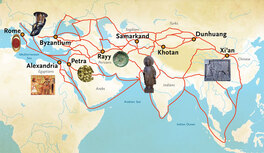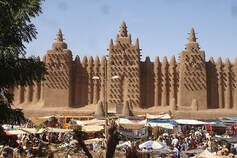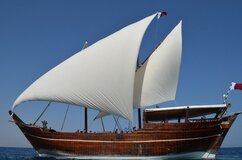Unit Two: Networks of Exchange (c. 1200 to c. 1450)
One of the earliest trade routes in world history is seen in my lesson on the Silk Road which also includes a map of the Silk Road routes in China. The lesson on the Mongol Empire tells how these nomadic people created the larges land-based empire in world history, best seen using a map of the Mongol Empire. How they ruled the areas of Asia and Europe is illustrated in a handout called the impact of the Mongol Empire. One of the many travelers who recorded their adventures is told in the document about Marco Polo during the Mongol Empire.
Special Assignment: Textbook reading and writing assignment on the Mongol Empire
See how much content has been understood by taking the short quiz on Afro-Eurasian Trade Circuits.
Special Assignment: Textbook reading and writing assignment on the Mongol Empire
See how much content has been understood by taking the short quiz on Afro-Eurasian Trade Circuits.
Scientific inventions and improved technology changed the overland trade routes. The era of better maritime vessels opened up new trade lanes. The Mediterranean Trade routes accompanied by the presentation of the Muslim Trade Routes and the Trade Routes of the Indian Ocean all relate to the changes in this era from land-based to sea-based trading. This link opens to a detailed map of the Indian Ocean Trade lanes similar to the one in the above lesson. In addition, this link opens to a map of the world's ocean currents and validates the rise of the Indian Ocean Trade Lanes.
This article below relates to the Muslim Trade Routes presentation.
The BBC in England recently published an excellent article with outstanding pictures on the annual rebuilding of the Djenne mosque in Mali. Please take a few moments to open and read this article.
This article below relates to the Muslim Trade Routes presentation.
The BBC in England recently published an excellent article with outstanding pictures on the annual rebuilding of the Djenne mosque in Mali. Please take a few moments to open and read this article.
In addition to Marco Polo, two other notable people told their stories. The first are the travels of the Buddhist Monk Xuanzang across Asia whose writing provided incredible insight as to the different societies that he visits on his journeys. The second traveler is more famous. The attached is a primary source extract with key questions on the explorations of the Muslim traveler Ibn Battuta. Berkeley ORIAS which is part of UC Berkeley, Office of Resources for International and Area Studies has created an outstanding website dedicated to Ibn Battuta. Not only does it cover his travels but it expands in details on the various cultures of the regions along with maps, pictures and videos. I have created a special series of questions based on the different sections of this site. The link to the special assignment on Ibn Battuta, A Virtual Tour, is a vital resource for all students to spend quality time on as it explains in depth society and their customs prior to the domination by European countries after 1450 C.E.


